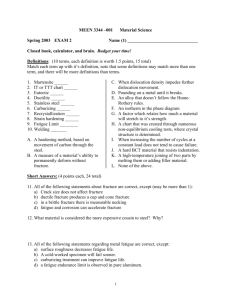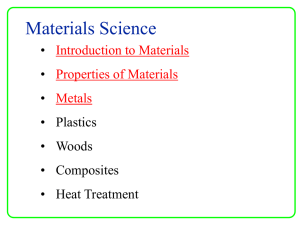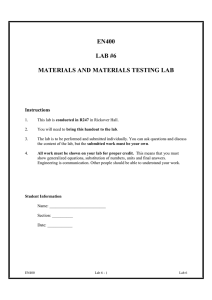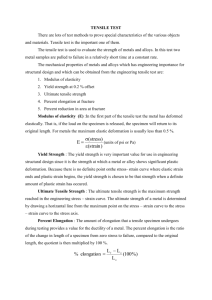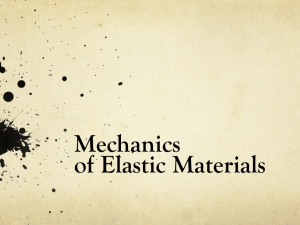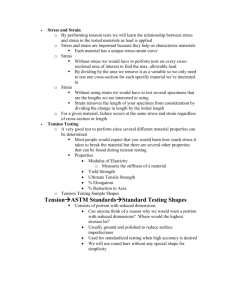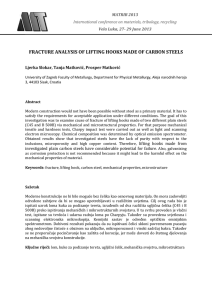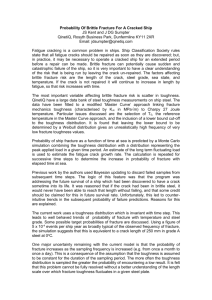Tensile Properties of Metals and Alloys Jesse Columbus Larry Lake
advertisement
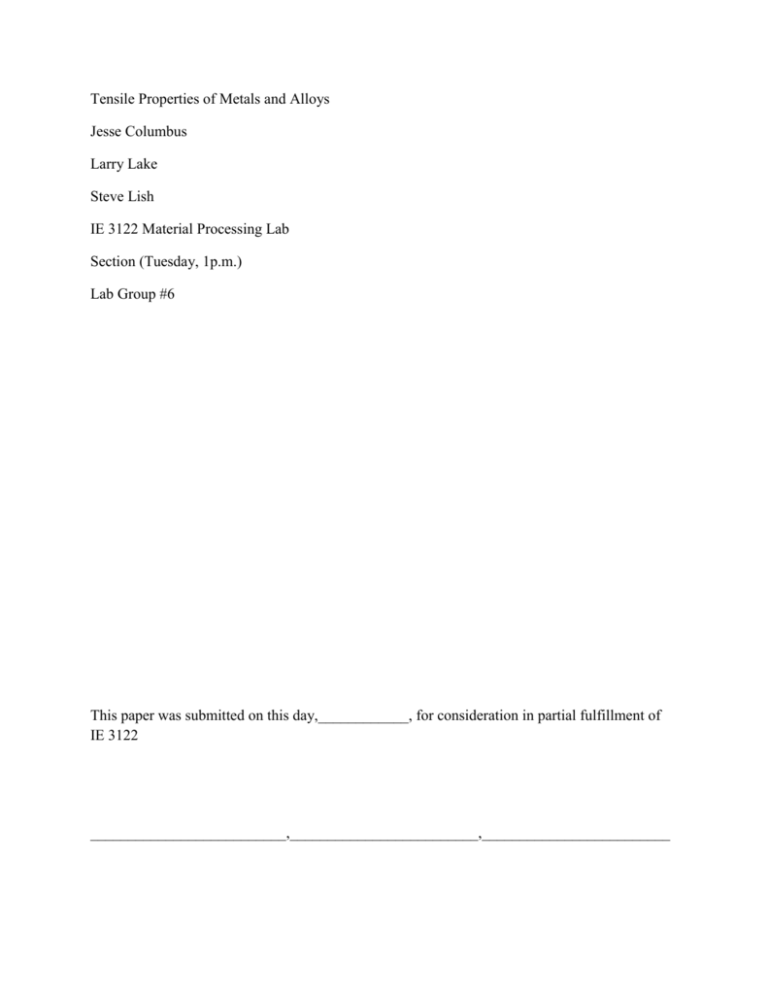
Tensile Properties of Metals and Alloys Jesse Columbus Larry Lake Steve Lish IE 3122 Material Processing Lab Section (Tuesday, 1p.m.) Lab Group #6 This paper was submitted on this day,____________, for consideration in partial fulfillment of IE 3122 __________________________,_________________________,_________________________ 3. The difference between engineering stress and true stress comes down to which cross sectional area is used. With engineering stress the initial cross sectional area is used throughout the stress strain curve, all stresses are computed using the initial area. True stress uses the instantaneous cross sectional area of the material in tension. The area of the cross section is always changing up until fracture. The difference in the graphs and tables is that engineering stress tapers off after the Ultimate Tensile Strength (UTS) and curves down till fracture. With the true stress strain graph the stress continues to rise up past the UTS until fracture. The stress is higher for true stress because the stress is concentrated at the necked cross sectional area as the cross section gets smaller the stress increases. 𝑇𝑟𝑢𝑒 𝑠𝑡𝑟𝑒𝑠𝑠 = 𝜎𝑎𝑡 𝑓𝑟𝑎𝑐𝑡𝑢𝑟𝑒 𝜎𝑓𝑟𝑎𝑐 =𝐴 𝑖𝑛𝑠𝑡𝑎𝑛𝑡𝑎𝑛𝑒𝑜𝑢𝑠 𝑎𝑟𝑒𝑎 𝐸𝑛𝑔𝑖𝑛𝑒𝑒𝑟 𝑠𝑡𝑟𝑒𝑠𝑠 = 𝑖𝑛𝑠𝑡𝑎𝑛𝑡 𝜎𝑎𝑡 𝑓𝑟𝑎𝑐𝑡𝑢𝑟𝑒 𝑖𝑛𝑡𝑖𝑎𝑙 𝑎𝑟𝑒𝑎 𝜎 = 𝑎 𝑓𝑟𝑎𝑐 𝑖𝑛𝑡𝑖𝑎𝑙 𝐴𝑟𝑒𝑎𝑖𝑛𝑠𝑡𝑎𝑛𝑡𝑎𝑛𝑒𝑜𝑢𝑠 = 𝐴𝑟𝑒𝑎𝑖𝑛𝑡𝑖𝑎𝑙 = 𝜋𝑑𝑓𝑖𝑛𝑎𝑙 2 4 𝜋𝑑𝑖𝑛𝑡𝑖𝑎𝑙 2 4 Aluminum Brass Steel 𝜋(.250")2 4 𝜋(.249")2 4 𝜋(.255")2 4 .04909𝑖𝑛2 .04869𝑖𝑛2 .05107𝑖𝑛2 𝜋(.162")2 4 𝜋(.147")2 4 𝜋(.162")2 4 . 02061 𝑖𝑛2 . 01697 𝑖𝑛2 . 02061 𝑖𝑛2 Force fracture 1,673 𝑙𝑏𝑠 1,939 𝑙𝑏𝑠 2,912 𝑙𝑏𝑠 𝑆𝑡𝑟𝑒𝑠𝑠𝑒𝑛𝑔𝑖𝑛𝑒𝑒𝑟 1673𝑙𝑏𝑠 . 04909𝑖𝑛2 1939𝑙𝑏𝑠 . 04869𝑖𝑛2 2912𝑙𝑏𝑠 . 05107𝑖𝑛2 34,080 𝑝𝑠𝑖 39,823 𝑝𝑠𝑖 57,019 𝑝𝑠𝑖 1673𝑙𝑏𝑠 . 02061𝑖𝑛2 1939𝑙𝑏𝑠 . 01697𝑖𝑛2 2912𝑙𝑏𝑠 . 02061𝑖𝑛2 81,174 𝑝𝑠𝑖 114,260 𝑝𝑠𝑖 141,290 𝑝𝑠𝑖 𝐴𝑟𝑒𝑎 𝑖𝑛𝑡𝑖𝑎𝑙 𝐴𝑟𝑒𝑎 𝑓𝑖𝑛𝑎𝑙 𝑆𝑡𝑟𝑒𝑠𝑠 𝑡𝑟𝑢𝑒 8. From the start of plastic deformation till the point of the UTS engineering stress increases. The reason why the stress increases up to the point of UTS is because the material is plastically deforming in a uniform fashion. The material in tension starts to work harden from the strain of plastic deformation increasing the stress needed to strain the part. The stress increases up until the UTS where necking forms causing the engineering stress of the part goes down until fracture. 9. In the later stage of plastic deformation, engineering stress decreases on the graph. This deceiving concept in which stress seems to diminish, happens because of necking. All of the stress concentrates at the necked region of the material. As the area decrease the stress actually increases in a true stress strain curve. Engineering stress does not use the instantaneous area of the necked region; it uses the initial cross sectional area of the material that is put in tension, therefore creating the appearance that the stress is decreasing when in fact it is actually increasing. 10. The carbon content of steel can greatly effects how the steel will perform and it is necessary for the producer to be aware of how it can affect strength resilience and toughness. Increasing the carbon content of steel can greatly increase the strength of steel by increasing the stress needed to deform the steel. Lowering the carbon content can lower the strength of it as well as increasing the ductility. Resilience and toughness go hand in hand; resilience is the area lying underneath the 𝜖 elastic deformation area up to the point of the yield strength. 𝑈𝑟 = ∫0 𝑦 𝜎𝑑𝜖 resilient materials are those with high yield strength and a low modulus of elasticity. High carbon steels have a high resilience and low carbon steels have a smaller resilience. Toughness is measured as the total area under the deformation curves, elastic and plastics regions of the stress strain curve. In terms it is the measure of the ability for a material to absorb energy up to the fracture point. Materials that are more ductile tend to have a higher toughness than those of a higher strength material. Lower carbon steels will be tougher than high carbon steel. Since high carbon steels have a high strength but low strain they will be considered less tough. 11. The reason why Lake Superior ore boats are not made of high strength steel alloy is because it is more vulnerable to cracking. With the variation in water temperatures the hulls of the ore boats tend to shrink in colder water and expand in warmer waters of the ocean. With a low strain rate of high carbon steel there is little leeway for this expansion and contraction to occur; this in turn would cause the boat to crack under drastic water temperature changes. That is why ore boats are made of a low carbon more ductile steel over tough high carbon steel. Aluminum: After tensile test, its final diameter was the least, showing that its ductility is the least. Final Length: 0.162” Final Diameter: 2.133” Brass: After tensile test it was the most ductile of the three alloys with a change in length 0.305”. Upon observation it is seen that the brass broke the most smoothly and also has the smallest final diameter Final Length: 0.147” Final Diameter: 2.154” Steel: After tensile test a large cup and cone at the fracture point was observed. This shows that the ductility in the steel is low than that of the other metals. Final Length: 0.162” Final Diameter: 2.154” Conclusion:


